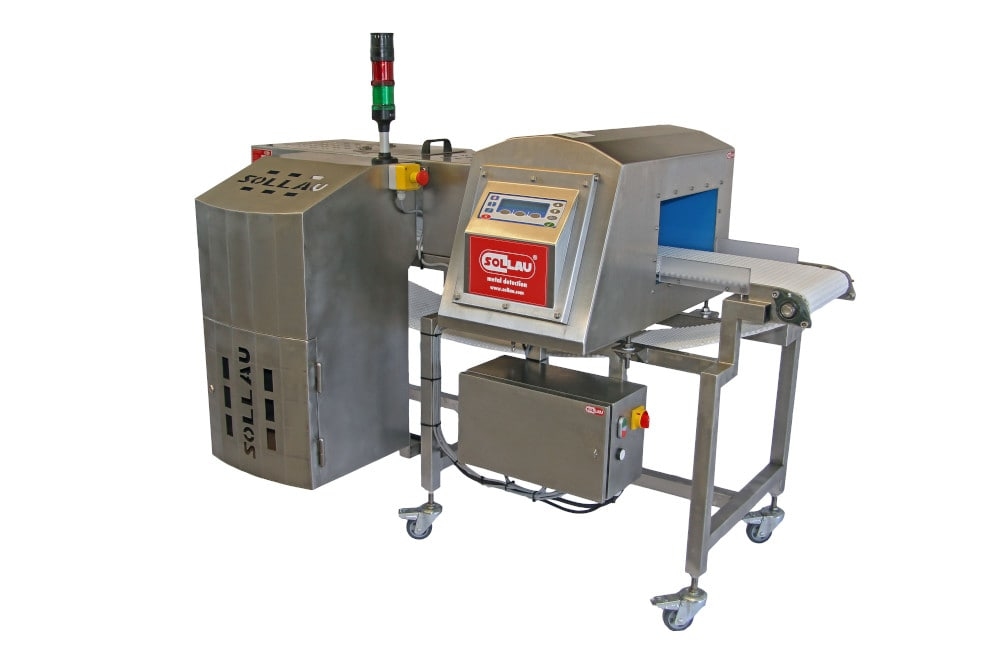2. 12. 2019
Metal detector or magnetic separator?

Many clients accept the false assumption that the application of a metal detector solves - in an easy and fast way – the problem with the removal of ferrous contaminants from the processed products. Unfortunately, this is not true, because the use of mere metal detectors for the detection and separation of undesirable ferromagnetic particles has many disadvantages:
Disadvantages of using only metal detector itself
Limited efficiency – for example free fall detectors with the inlet diameter of 200 mm are usually not able to catch metal particles smaller than 1.5 mm. However, just these particles pose a significant risk of harm to the end users, because pieces of wires, metal shavings etc. of this size can get into the processed final product. By contrast, magnetic separators are able to separate ferromagnetic particles from 30 μm and eliminate in this way any risk of harm caused by ferrous contaminants.
Price – free fall metal detectors are considerably more expensive than magnetic separators of similar inlet diameters
Susceptibility to damage – metal detectors are electronic and in addition to that very sensitive devices. Their damage or efficiency decrease are results of internal as well as external influences (vibrations, cleaned material, electrical smog, unsuitable placement etc.), while the subsequent repairs as well as the standard maintenance are time consuming and very costly at the same time. On the other hand, the magnetic separators are purely mechanical and nearly maintenance free machines (with all the corresponding advantages referring to their service, maintenance and lifetime).
Economy – metal detectors are not able to separate only the particular (detected) piece of ferrous metal and that is why a certain (bigger or smaller) amount of good material is always discarded together with the undesirable contaminant. It can result (especially in case of expensive materials) in significant financial losses. A magnetic separator can separate ferrous particles with a minimum admixture of the processed material. Besides, the magnetic separator does not require electrical energy to power its instrumentation (with the exception of some special motor versions) and it is therefore more economic from this point of view too.
Efficiency – as metal contaminants comprise some 70 % of ferromagnetic particles, the application of magnetic separators is, in general, more efficient than the application of metal detectors. On the top of it, the strong neodymium magnets in the latest versions of magnetic separators are able to capture also stainless steel, partly magnetic or even paramagnetic particles. And also the mode of material processing has an indirect positive effect on the efficiency of the magnetic separators: the product to be cleaned is during processing very often in contact with ferromagnetic metals (pipelines, ferromagnetic contaminants in the material etc.), and as a consequence of such contact even standardly non-magnetic contaminants can be magnetised and afterwards caught by magnetic separators....
Applicability – installation of metal detectors is more complicated, they need more space at the place of application, the metal detectors cannot work without power supply, they have a lower weather resistance and that is why their application is limited to the interior etc. However, the magnetic separators can be installed more or less anywhere.
What to use then - either a metal detector or a magnetic separator?
If the undesirable contaminants have only ferromagnetic character, there is no other more efficient and cheaper solution than the application of the magnetic separator.
Nevertheless, in some specific industrial branches with high demands on quality and safety of the final products (for example food industry, pharmaceutical industry) it is not sufficient enough to remove from the processed materials only the ferrous particles. In these cases we recommend that a magnetic separator is placed in the production line and a metal detector installed at the output end. This kind of production line configuration will arrange for very effective removal of both ferromagnetic and non-magnetic metal contaminants and this is the main reason, why we opt for a combined application of both the devices very often (and not only in the cases of food processing companies).
Solution for your production line
As each production line is quite specific, we recommend that you either contact our commercial department or fill in the contact form below. We will elaborate a solution tailored to your individual needs.
